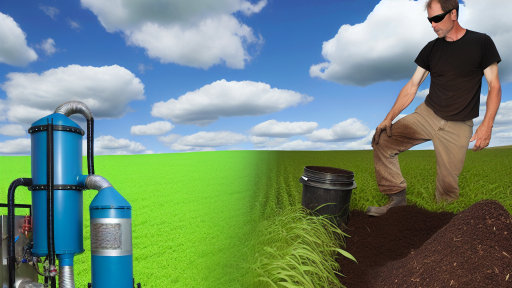Introduction
Eco-friendly farming plays a crucial role in modern agriculture.
It emphasizes practices that protect the environment.
These methods reduce chemical use and promote biodiversity.
As the global population grows, eco-friendly solutions become vital.
Farmers increasingly recognize the importance of sustainability.
Eco-friendly farming enhances soil health and water quality.
This approach also mitigates climate change impacts.
By adopting these practices, farmers can create a healthier ecosystem.
In addition to environmental benefits, farmers can save costs.
Organic fertilizers and pest control often reduce input expenses.
Long-term investment in sustainable methods leads to lower overall costs.
Eco-friendly practices, like crop rotation and cover cropping, minimize erosion and boost yields.
Healthier soil supports robust plants that require fewer external resources.
Additionally, eco-friendly techniques enhance product quality.
Consumers increasingly seek organic and sustainably sourced products.
Transform Your Agribusiness
Unlock your farm's potential with expert advice tailored to your needs. Get actionable steps that drive real results.
Get StartedThis growing demand allows farmers to charge premium prices.
More consumers prefer responsible farming methods, leading to a valuable market opportunity.
This post will explore the methods and benefits of eco-friendly farming.
We will discuss practical strategies for implementation.
We will examine real-world examples of successful farms.
By the end, you will understand how to adopt eco-friendly practices.
You will see how these methods can save costs while benefiting the planet.
Embracing eco-friendly farming is not just a trend; it is essential for the future.
Sustainable agriculture protects natural resources for generations to come.
With the right knowledge and tools, farmers can make a positive impact.
The journey towards sustainability starts here, with actionable steps and informed choices.
Understanding Eco-Friendly Farming
Eco-friendly farming, often referred to as sustainable farming, emphasizes practices that are environmentally friendly.
This method seeks to balance the need for food production with the preservation of natural resources.
The core principles of eco-friendly farming include:
- Soil health: Maintaining soil fertility through natural amendments like compost.
- Biodiversity: Encouraging diverse species in farming systems to enhance resilience.
- Reduced chemical usage: Minimizing or eliminating synthetic fertilizers and pesticides.
- Water conservation: Implementing techniques that reduce water waste, such as drip irrigation.
- Crop rotation: Rotating crops to improve soil nutrients and reduce pests.
- Integrated pest management: Combining biological, cultural, and mechanical practices to manage pests sustainably.
A thriving farming ecosystem relies on biodiversity, soil health, and effective resource conservation.
Each of these factors plays a crucial role in sustainable agriculture.
Biodiversity
- Increases resilience: Diverse crops withstand pests and diseases better than monocultures.
- Enhances ecosystem services: Beneficial insects and microorganisms contribute to pollination and pest control.
- Improves yields: Diverse farms can produce more food on the same area of land.
Soil Health
- Nutrient cycling: Healthy soils recycle nutrients, making them available for crops over time.
- Water retention: Soil rich in organic matter retains moisture, reducing irrigation needs.
- Microbial activity: A diverse microbial community improves soil structure and fertility.
Resource Conservation
- Reduced inputs: Sustainable practices lower the need for chemical fertilizers and toxic pesticides.
- Energy savings: Eco-friendly methods tend to require less energy and fossil fuel.
- Water management: Efficient water use minimizes waste and preserves local water sources.
How Eco-Friendly Practices Mitigate Climate Change
Climate change poses significant challenges to agriculture.
However, eco-friendly farming practices offer solutions to mitigate these impacts.
Here’s how:
Carbon Sequestration
- Soil organic matter: Increasing organic matter in soils captures carbon from the atmosphere.
- Agroforestry: Integrating trees into farms can enhance carbon storage and improve biodiversity.
Reducing Greenhouse Gas Emissions
- Less synthetic fertilizers: Reducing fertilizer use lowers nitrous oxide emissions.
- Efficient livestock management: Sustainable grazing practices can reduce methane emissions from ruminants.
Resilient Crop Systems
- Diverse cropping systems: Diverse systems offer better resistance to extreme weather events.
- Restoring ecosystems: Farmers can restore wetlands and other ecosystems to buffer against climate impacts.
Future Directions for Sustainable Agriculture
Understanding eco-friendly farming is crucial for anyone interested in agriculture’s future.
This approach integrates principles that significantly benefit the environment.
By boosting biodiversity, health of soil, and efficient resource conservation, farmers can maintain productive lands.
Moreover, these practices help combat climate change.
Embracing eco-friendly methods leads to not only financial savings but also planetary savings.
Showcase Your Farming Business
Publish your professional farming services profile on our blog for a one-time fee of $200 and reach a dedicated audience of farmers and agribusiness owners.
Publish Your ProfileAs more farmers adopt eco-friendly practices, we inch closer to a sustainable food system that benefits everyone.
Cost-Effective Sustainable Practices
Adopting eco-friendly farming practices is not just good for the planet.
It is also beneficial for your wallet.
Farmers can reduce costs significantly while contributing to a healthier ecosystem.
This section explores low-cost eco-friendly practices.
We will focus on crop rotation, cover cropping, and permaculture.
These methods lower dependency on chemical fertilizers and pesticides.
By implementing these practices, farmers enhance sustainability and boost their bottom line.
Crop Rotation
Crop rotation involves planting different crops in the same area in sequential seasons.
This practice prevents soil nutrient depletion.
It also disrupts pest and disease cycles.
As a result, farmers can reduce the need for chemical interventions.
Here are some benefits:
- Nutrient Management: Different crops absorb different nutrients.
- Pest Control: Rotating crops disrupts pest life cycles, reducing infestations.
- Soil Structure: Diverse root systems improve soil structure and aeration.
- Yields: Improved soil health leads to better yields over time.
A study by the Rodale Institute showed that farms practicing crop rotation yield more compared to monoculture farms.
Farmers can choose crops that complement each other, such as alternating between legumes and cereals.
Legumes fix nitrogen in the soil, benefiting subsequent crops.
Cover Cropping
Cover cropping is planting crops primarily for soil protection rather than harvest.
These crops, like clover or rye, cover the soil during off-seasons.
They offer numerous financial and environmental benefits:
- Soil Erosion Prevention: Cover crops hold soil in place, preventing erosion from wind and water.
- Nitrogen Fixation: Leguminous cover crops enrich the soil with nitrogen, reducing fertilizer needs.
- Weed Suppression: Dense cover crops hinder weed growth, lowering herbicide requirements.
- Soil Moisture Retention: They help retain soil moisture, reducing irrigation costs.
The effectiveness of cover cropping is well-documented.
Research indicates that cover cropping reduces erosion by up to 90 percent.
Farmers can plant these crops in late summer or fall, allowing them to grow until the main planting season.
This strategy minimizes costs associated with fallow land.
Permaculture
Permaculture is a holistic design system for sustainable agriculture.
It mimics natural ecosystems, promoting biodiversity and sustainability.
Adopting permaculture practices can lower costs as well.
Here are some of the core principles:
- Diversity: Integrating various plants and animals increases resilience.
- Soil Health: Emphasizing composting and organic matter enhances soil fertility naturally.
- Water Management: Utilizing rainwater harvesting techniques reduces irrigation costs.
- Local Resources: Permaculture relies on local resources, minimizing transportation costs.
Farmers implementing permaculture often see substantial savings.
For example, a farm may use greywater for irrigation, dramatically reducing water bills.
Another aspect of permaculture is creating guilds, cooperating plants that support each other’s growth.
This diversified approach enhances food security and offers economic flexibility.
Real-Life Examples of Successful Implementation
Several farms around the world exemplify the cost savings and environmental benefits of sustainable practices:
- Polyface Farm: Located in Virginia, this farm uses rotational grazing, improving soil health and reducing feed costs.
- Rodale Institute: This research farm showcases cover cropping and crop rotation. They report higher yields and reduced chemical usage.
- Green Roofs for Healthy Cities: This initiative focuses on urban agriculture, using permaculture principles to transform city spaces.
- Earth Haven Ecovillage: This community integrates permaculture and agroforestry, demonstrating the benefits of diverse planting systems.
These successful farms highlight the possibilities of eco-friendly farming.
Not only do they reduce costs, but they also promote ecological balance.
Observing their methods inspires other farmers to adopt similar practices.
Transitioning to Sustainable Practices
Transitioning to cost-effective, sustainable practices is essential.
Crop rotation, cover cropping, and permaculture are practical and financially viable strategies.
They significantly reduce dependency on chemical fertilizers and pesticides, saving farmers money.
Additionally, these practices contribute to a healthier environment.
Many successful farms already utilize these techniques.
Showcase Your Farming Business
Publish your professional farming services profile on our blog for a one-time fee of $200 and reach a dedicated audience of farmers and agribusiness owners.
Publish Your ProfileEmbracing these methods is a step toward a more sustainable and prosperous future.
Gain More Insights: The Rise of Zero-Waste Farms: A Blueprint for Sustainability
Water Scarcity Issues Facing Farmers Today
Farmers across the globe grapple with severe water scarcity issues.
In many regions, droughts have become more frequent and intense.
Climate change significantly aggravates this situation.
As a result, many farmers witness reduced crop yields.
This trend threatens food security worldwide.
Poor water management practices further complicate these challenges.
Traditional irrigation methods often waste significant water resources.
Farmers need to adapt to these ongoing changes.
They must seek efficient water conservation techniques to ensure sustainability.
The demand for water continues to grow with the increasing global population.
As more people require food, the pressure on water resources intensifies.
Given these realities, conserving water has never been more critical for farmers.
Techniques for Conserving Water
Farmers can adopt several innovative techniques to efficiently conserve water.
Here are some effective methods:
- Rainwater Harvesting: Collecting rainwater is an effective way to supplement water supply. Farmers can store rainwater in barrels or tanks for later use. This technique reduces reliance on groundwater and surface water. It also helps mitigate runoff, preventing soil erosion.
- Drip Irrigation: Drip irrigation delivers water directly to the roots of plants. This method significantly minimizes water waste. Farmers can save as much as 50% of water compared to traditional irrigation systems. This targeted method also promotes healthier plants.
- Mulching: Applying a layer of mulch around plants conserves soil moisture. Organic or synthetic mulch can reduce evaporation. It also suppresses weed growth, which competes for moisture. This technique enhances soil health and nutrient retention.
- Soil Moisture Sensors: Utilizing technology improves water application efficiency. Soil moisture sensors help determine when and how much to water. This data-driven approach reduces overwatering and conserves resources. It allows farmers to respond promptly to their crops’ needs.
- Field Contouring: Creating contours on fields slows water runoff. It allows for better water absorption into the soil. This technique reduces erosion and promotes even moisture distribution. Farmers can improve crop yields by enhancing soil moisture retention.
Cost Benefits of Implementing Water Conservation Techniques
Understanding the cost benefits of water conservation techniques is vital.
Implementing these methods provides long-term financial advantages over traditional irrigation methods.
Initial Investment and Long-term Savings
Many water conservation techniques require an initial investment, but this pays off in the long run. Here’s how:
- Reduced Water Bills: By conserving water, farmers witness lower water bills. Investing in systems like drip irrigation and rainwater harvesting can significantly reduce costs.
- Less Energy Consumption: Traditional irrigation methods consume significant energy for pumping water. Increased efficiency in water use translates to lower energy costs. Efficient systems require less electricity to operate, leading to direct savings.
- Crop Resilience: Healthier plants thrive with proper moisture management. Adopting efficient practices leads to better yields. Farmers can sell more produce and increase their revenue.
- Improved Soil Health: Techniques like mulching enrich soil over time. Healthier soils can retain moisture better, reducing the need for supplemental watering. Substantial long-term cost savings are realized through better soil management.
- Increased Eligibility for Incentives: Governments and organizations often offer incentives for sustainable farming practices. Farmers implementing water-saving techniques can access grants and subsidies. This financial support can further offset costs.
Risk Mitigation
Water conservation techniques also help mitigate risks associated with water scarcity:
- Buffer Against Drought: By harvesting rainwater, farmers create a buffer against drought conditions. This stored water ensures crop survival during dry spells.
- Improved Predictability: Utilizing technology like soil sensors leads to better water management. Farmers can anticipate crop needs and respond accordingly, reducing uncertainty.
- Adaptability to Climate Change: As climate change affects rainfall patterns, efficient systems foster adaptability. Farmers who embrace conservation are better prepared for weather fluctuations.
- Higher Market Competitiveness: Farmers who conserve water can produce more consistently. This reliability makes them more competitive in the market.
Strategies for Sustainable Farming Practices
Water conservation remains essential in today’s agricultural landscape.
Farmers must prioritize innovative techniques like rainwater harvesting, drip irrigation, and mulching.
These methods not only safeguard essential resources but also provide remarkable cost benefits.
By conserving water, farmers protect their livelihoods while contributing to global sustainability.
The direct savings, enhanced crop resilience, and risk mitigation create a compelling case for these practices.
Every farmer has an opportunity to lead the way toward a greener future.
Find Out More: Why Crop Rotation Is Crucial for Sustainable Soil Health
Soil Health and Fertility Management
Maintaining healthy soil is crucial for successful eco-friendly farming.
Healthy soil leads to improved crop yields and reduces the need for chemical fertilizers.
Additionally, it contributes to a more resilient farming system that can withstand environmental stress.
As we focus on eco-friendly practices, soil health becomes a foundational element that supports both productivity and sustainability.
Importance of Healthy Soil
Soil acts as the backbone of agricultural systems.
Healthy soil provides essential nutrients, water retention, and habitat for beneficial organisms.
Its structure influences drainage and aeration, which are vital for plant growth.
Furthermore, healthy soil can sequester carbon, helping combat climate change.
Here are key reasons why maintaining healthy soil matters:
- Nutrient Supply: Healthy soil nourishes plants with essential nutrients.
- Water Retention: Good soil structure improves water retention, reducing irrigation needs.
- Soil Microbiology: Healthy soil supports diverse microbial life, promoting disease resistance.
- Soil Structure: Proper soil structure enhances aeration and root growth.
- Ecosystem Services: Healthy soil contributes to biodiversity and ecosystem balance.
Strategies to Improve Soil Health
Adopting effective strategies can enhance soil health.
Here are some proven methods:
Composting
Composting enriches soil by returning organic matter.
It improves soil structure and increases nutrient availability.
Showcase Your Farming Business
Publish your professional farming services profile on our blog for a one-time fee of $200 and reach a dedicated audience of farmers and agribusiness owners.
Publish Your ProfileThe process involves decomposing plant materials, kitchen scraps, and yard waste.
- Nutrient-Rich Input: Compost provides a balance of nutrients essential for plant growth.
- Improved Soil Structure: Compost enhances soil aeration and moisture retention.
- Reduced Waste: Composting helps minimize organic waste sent to landfills.
Organic Amendments
Organic amendments include materials like manure, cover crops, and green manures.
These inputs boost soil fertility and improve health over time.
- Natural Fertilization: Organic amendments supply nutrients without synthetic chemicals.
- Microbial Activity: Adding organic materials stimulates beneficial microorganisms.
- Soil Structure Improvement: These amendments enhance soil aggregation and stability.
Reduced Tillage
Reducing tillage minimizes soil disturbance.
This practice helps maintain soil structure and reduces erosion.
It also supports the habitat of beneficial soil organisms.
- Conservation of Soil Structure: Reduced tillage helps maintain soil integrity.
- Enhanced Water Retention: It minimizes surface runoff and improves infiltration.
- Lower Erosion Risk: Reduced tillage decreases the chances of soil erosion.
Crop Rotation
Implementing crop rotation involves changing the type of crop grown in a specific area each season.
This practice helps prevent soil depletion and pest buildup.
- Diverse Nutrient Needs: Different crops utilize varying nutrients, maintaining balance.
- Pest and Disease Control: Rotating crops disrupts pest life cycles.
- Soil Fertility Maintenance: Rotations with legumes can fix nitrogen, enhancing fertility.
Cover Cropping
Cover crops are planted during off-seasons for soil protection and enhancement.
They prevent erosion, suppress weeds, and maintain moisture.
- Soil Cover: Cover crops shield the soil from harsh weather conditions.
- Nutrient Cycling: They contribute organic matter to the soil when tilled back.
- Weed Suppression: Cover crops limit weed growth, reducing the need for herbicides.
Financial Advantages of Maintaining Soil Fertility
Using eco-friendly methods for soil management offers financial benefits.
Reducing reliance on synthetic inputs lowers costs and increases profit margins.
Decreased Input Costs
Utilizing compost and organic amendments reduces the need for expensive chemical fertilizers.
This shift cuts costs over time.
Increased Crop Yields
Healthy soil leads to increased plant growth and yields.
Greater productivity translates into higher revenues for farmers.
Improved Resilience
Healthy soil builds resilient farming systems.
This resilience helps mitigate losses during adverse weather events.
Enhanced Market Opportunities
Demand for organic and sustainably grown produce is increasing.
Farmers with healthy soil can tap into this lucrative market.
Long-Term Sustainability
Caring for soil today ensures productivity for future generations.
Sustainable practices lead to ongoing cost savings and resource availability.
Prioritizing Soil Management for a Sustainable Future
Prioritizing soil health is essential for eco-friendly farming.
Implementing strategies like composting, organic amendments, and reduced tillage enhances soil fertility.
The financial benefits create a compelling case for sustainable practices.
Investing in healthy soil today will yield benefits tomorrow for farmers and our planet.
See Related Content: 8 Sustainable Farming Hacks You Need to Know Now
Overview of Integrated Pest Management (IPM)
Integrated Pest Management (IPM) combines various strategies to manage pests effectively and sustainably.
Farmers implement IPM to promote crop health while minimizing environmental impact.
This approach relies on the careful monitoring of pest populations and understanding of ecosystem interactions.
The core idea is to use a combination of methods tailored to specific conditions rather than relying on chemical pesticides alone.
IPM offers several eco-friendly benefits, including:
- Reduction of Chemical Use: IPM significantly lowers the need for chemical pesticides, decreasing potential harm to the environment.
- Enhanced Biodiversity: By encouraging beneficial insects and other organisms, IPM fosters a balanced ecosystem.
- Soil Health Improvement: Practices inherent in IPM, such as crop rotation, support soil vitality and reduce erosion.
- Pest Resistance Management: Diverse strategies reduce the likelihood of pests developing resistance to treatments.
- Cost Savings: Utilizing natural pest control methods can lead to significant long-term savings.
Cost-effectiveness of Using Biological Control Methods
Employing biological control methods in IPM can offer substantial cost advantages over chemical pesticides.
While some might view initial setup costs as high, the long-term savings often outweigh these expenses.
Biological control involves using natural predators or parasites to manage pest populations, leading to lower overall costs.
Consider the following cost-effective benefits of biological control methods:
- Reduced Purchasing Expenses: Farmers can minimize spending on chemical inputs by using natural predators, leading to immediate savings.
- Lower Application Costs: Biological methods often require less frequent application, reducing labor and machinery costs.
- Long-lasting Effects: Natural enemies can provide prolonged pest control benefits, decreasing the need for repeated treatments.
- Enhanced Marketability: Produce grown with biological controls can attract premium prices, appealing to eco-conscious consumers.
Case Studies of IPM Success
Numerous case studies showcase the success of Integrated Pest Management in enhancing crop resilience and reducing pest-related losses.
These examples illustrate how IPM strategies allow for sustainable farming practices that benefit both the environment and farmers.
Case Study 1: Tomato Production
In a trial involving tomato farms, growers adopted IPM techniques to manage aphids.
They introduced ladybugs, natural predators of aphids, into their fields.
Showcase Your Farming Business
Publish your professional farming services profile on our blog for a one-time fee of $200 and reach a dedicated audience of farmers and agribusiness owners.
Publish Your ProfileWithin weeks, farmers noticed a drop in aphid populations.
This decrease led to a 30% reduction in chemical pesticide use.
The benefits of this approach included:
- Improved Crop Yields: With fewer pests attacking plants, farmers reported a significant increase in tomato quality and quantity.
- Cost Savings: Farmers saved an average of $200 per acre in pesticide costs.
- Long-term Soil Adoption: The positive results encouraged more sustainable soil practices, creating healthier ecosystems.
Case Study 2: Citrus Groves
Your average citrus grove experienced significant challenges with scale insects.
Farmers implemented an IPM program that integrated the introduction of parasitic wasps into their groves.
This biological agent effectively targeted scale populations, often resulting in over 70% control within a few months.
Benefits from this approach included:
- Enhanced Crop Health: Reduced pest pressure improved the overall health of the citrus trees.
- Reduced Chemical Dependency: Farmers reduced chemical pesticide applications by nearly 60%, aligning with eco-friendly practices.
- Increased Consumer Confidence: With a visible decrease in chemical use, growers marketed their products as sustainably grown.
Case Study 3: Apple Orchards
In a well-documented case, apple orchards faced challenges from codling moths.
The farmers chose to implement an IPM strategy that included pheromone traps and natural predatory insects.
The traps effectively monitored moth populations, allowing timely interventions without blanket pesticide applications.
This strategy yielded significant results:
- Higher Fruit Quality: The reduction of pest-related damage led to higher-quality apples ready for market.
- Cost Efficiency: The cost associated with managing pests dropped by over 50%, allowing farmers to profit more.
- Environmental Benefits: Less reliance on chemical pesticides contributed to improved water quality and healthier pollinator populations.
Implications of Integrated Pest Management
Integrated Pest Management stands as a vital component of eco-friendly farming practices.
By embracing biological control methods, farmers can cut costs while preserving the ecosystem.
The success stories from various agricultural sectors highlight the effectiveness of IPM strategies.
These examples serve as a roadmap for farmers looking to enhance sustainability while maximizing profitability.
Adopting IPM not only nurtures the planet but also supports farmers’ economic stability.
The path forward includes innovation, collaboration, and commitment to sustainable practices.
In this evolving agricultural landscape, IPM represents a forward-thinking approach, blending profitability with environmental stewardship.
You Might Also Like: Integrated Pest Management: Biodiversity Booster

Community Supported Agriculture (CSA) and Local Markets
Community Supported Agriculture (CSA) represents a compelling shift in farming practices.
It allows consumers to buy directly from local farms.
This arrangement creates a mutually beneficial relationship between farmers and consumers.
It promotes sustainable farming and reduces reliance on mass-produced agricultural products.
Advantages of CSA for Farmers and Consumers
CSAs thrive on partnerships between farmers and local consumers.
This model provides numerous advantages:
- Financial Stability: Farmers receive upfront payments for their produce.
- Consumer Loyalty: CSA members often feel a stronger bond with their local farmers.
- Reduced Marketing Costs: By selling produce directly to consumers, farmers save on marketing expenses.
- Freshness and Variety: CSAs offer seasonal produce.
- Sharing Risks: CSAs help mitigate risks in farming.
How Localizing the Food Supply Chain Decreases Costs and Environmental Impact
Shifting to a localized food supply chain reduces environmental impacts significantly.
This change leads to more sustainable food production methods.
Here’s how localizing food systems benefits everyone:
- Lower Carbon Footprint: By reducing transportation distances, CSAs cut down greenhouse gas emissions.
- Support for Local Economies: Money spent in local markets circulates within the community.
- Improved Food Quality: Local food tends to be fresher and more nutritious.
- Reduced Packaging Waste: Local supply chains often rely less on packaging materials.
- Encouragement of Sustainable Practices: Local farmers are more likely to adopt eco-friendly techniques.
Success Stories from Farmers Who Have Transitioned to CSA Models
Many farmers have embraced the CSA model, witnessing substantial benefits.
Their stories inspire others to adopt similar practices:
- Case Study: Oak Hill Farm: This family-owned farm in California transitioned to CSA three years ago.
- Case Study: Green Acres Farm: Located in Minnesota, Green Acres farm shifted to a CSA model during economic downturns.
- Case Study: Rocky Ridge Farm: After moving to a CSA model, this farm reduced food waste significantly.
- Case Study: Spring Valley Farm: This Virginia-based farm incorporates educational workshops for CSA members.
- Case Study: Prairie Sky Farm: By adopting CSA practices, this farm improved its sustainability practices.
Transitioning to a CSA model offers plenty of rewards for farmers.
They foster community relationships and build resilient local food economies.
Consumers benefit from fresher, healthier food choices while supporting sustainable practices.
Together, they help create a better food system.
Challenges and Considerations
Adopting eco-friendly farming practices can present numerous challenges.
Farmers often face barriers that can impede their transition.
Understanding these obstacles is crucial for successful implementation.
Barriers to Adoption
Several key barriers make it difficult for farmers to adopt eco-friendly practices:
- Initial Costs: The upfront financial investment in eco-friendly technology can be significant. Equipment and organic seeds tend to cost more than conventional options.
- Education: Many farmers lack the knowledge to implement sustainable methods effectively. Without proper training, they may stick to traditional practices.
- Market Access: Eco-friendly products often face limited market access. Finding buyers who value sustainable practices can be challenging.
- Pest Management Concerns: Farmers often worry about pest infestations without synthetic pesticides. Effective organic pest management requires new strategies and knowledge.
- Time Investment: Implementing eco-friendly practices can require significant time and effort. Many farmers juggle various responsibilities and may struggle to find time for education.
Strategies to Overcome Challenges
Farmers can effectively tackle these challenges using various strategies:
- Grants and Subsidies: Seeking grants and subsidies can alleviate initial costs. Various government and non-profit organizations offer financial assistance for eco-friendly initiatives.
- Cooperative Networks: Joining cooperative groups can provide collective purchasing power. Farmers can share resources and knowledge, reducing individual costs.
- Educational Workshops: Participating in workshops can increase knowledge about sustainable farming. Many organizations offer training programs designed to educate farmers about eco-friendly practices.
- Mentorship Programs: Establishing mentorship programs can connect experienced eco-friendly farmers with newcomers. Learning from someone who has successfully transitioned can ease the process.
- Alternative Marketing Strategies: Developing e-commerce platforms or participating in local farmers’ markets can expand market access. These strategies can help farmers reach consumers directly, boosting sales of eco-friendly products.
Importance of Market Awareness
Market awareness plays a pivotal role in supporting eco-friendly farmers.
Showcase Your Farming Business
Publish your professional farming services profile on our blog for a one-time fee of $200 and reach a dedicated audience of farmers and agribusiness owners.
Publish Your ProfileEducating consumers about the value of sustainable products fosters demand.
Understanding these points can help motivate consumers to choose eco-friendly options.
Consumer Education
Consumers need education about the benefits of eco-friendly products, including:
- Health Benefits: Eco-friendly produce often contains fewer chemicals. Consumers will benefit from eating healthier food.
- Environmental Impact: Educating consumers on how sustainable practices reduce carbon footprints can drive demand. Understanding how eco-friendly farming benefits the planet is essential.
- Support for Local Farmers: Consumers often prefer supporting local economies. By buying eco-friendly products, they contribute to the farmer’s success.
- Quality Awareness: Studies show that eco-friendly products often taste better. Educating consumers about quality can make a significant difference.
- Seasonality: Understanding the importance of seasonal buying can help consumers appreciate local harvests. This awareness can lead to greater support for local farmers.
Marketing Strategies
Farmers can adopt various marketing strategies to increase their market presence:
- Storytelling: Sharing their farming journey can resonate with consumers. Storytelling humanizes the farming experience and fosters connections.
- Social Media Engagement: Actively engaging on social media platforms can broaden outreach. Informative posts can raise awareness about sustainable practices.
- Brand Collaborations: Partnering with eco-friendly brands can enhance visibility. Collaborating can lead to mutually beneficial marketing efforts.
- Community Events: Hosting farm tours or community events can showcase eco-friendly practices. These events can provide education and help consumers connect with the farm.
- Customer Testimonials: Positive testimonials from satisfied consumers can influence potential buyers. Sharing these reviews can build trust and credibility.
Transitioning to eco-friendly farming involves various challenges and considerations.
Initial costs, lack of education, and limited market access pose significant obstacles.
However, farmers can overcome these hurdles using strategies like grants and cooperative networks.
Market awareness and consumer education remain critical.
By understanding the benefits of eco-friendly products, consumers can drive demand.
Education fosters a supportive environment, enabling farmers to thrive while saving the planet.
Together, farmers and consumers can create a brighter, sustainable future.
Eco-Friendly Farming: A Path to Sustainability
In this post, we explored how eco-friendly farming benefits both the environment and farmers’ wallets.
We discussed several strategies that cut costs while saving the planet.
By embracing practices such as crop rotation, organic pest control, and natural fertilizers, farmers can enhance soil health and boost yields.
These methods also reduce dependency on expensive chemical inputs, leading to significant savings.
Integrating technology in farming makes sustainability more accessible.
Precision farming tools, such as soil sensors and drones, maximize efficiency and minimize wastage.
Farmers can monitor crop health and resource usage closely, allowing informed decisions that further increase profitability.
We highlighted that eco-friendly practices can attract a growing market of environmentally conscious consumers.
As demand for sustainable products rises, farmers who adopt green practices can command higher prices.
Not only do these methods positively impact the environment, but they also open new revenue streams.
Farmers should view eco-friendly farming as a viable option for achieving long-term success.
Sustainable practices help secure soil for future generations and build resilient ecosystems.
They align profit and planet, fostering a healthier environment without sacrificing economic stability.
Ultimately, the collective effort towards sustainable farming matters significantly.
If every farmer contributes to reducing their ecological footprint, we can make a profound impact on our planet.
Together, we can protect our resources for future generations.
We encourage farmers to take action today.
Evaluate your current practices and implement sustainable methods that resonate with your values.
In doing so, you will not only save money but also help preserve our planet for years to come.
Additional Resources
A beginner’s guide to sustainable farming
Combat Food Waste with Sustainable Agriculture & Farming | Shapiro




